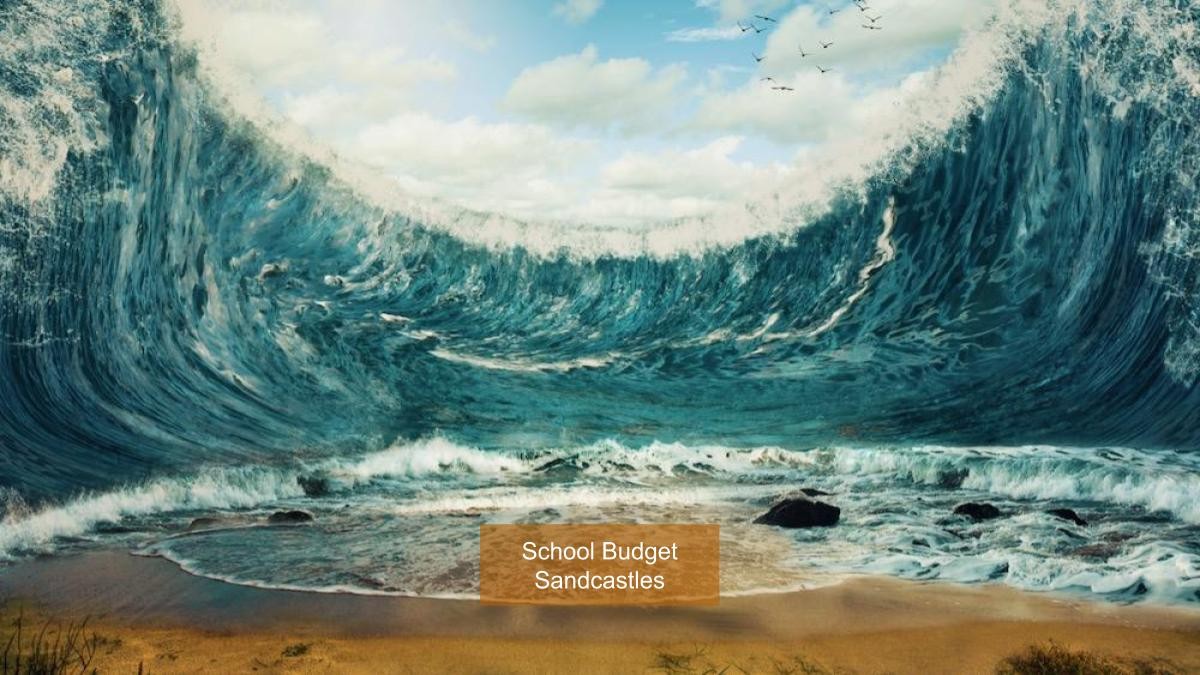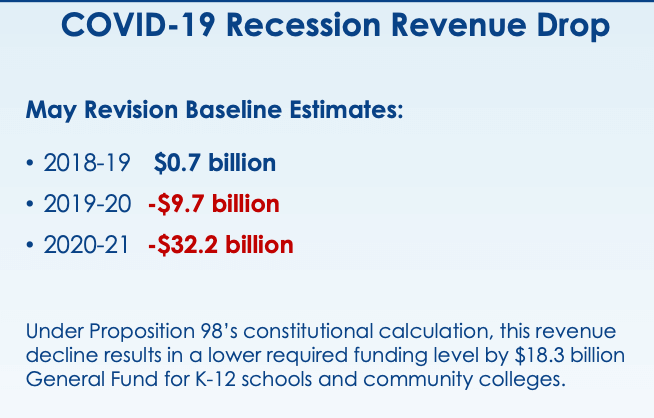Will School Budgets Survive?

To Open Safely, Schools Need More Money, not Less
A tsunami is about to wipe out California school budgets like sandcastles on a beach. The California Education Coalition, a combination of the state's major education organizations, is sounding the alarm. The funds proposed in the education budget are grossly insufficient. Without more funding, vital school services will be swept away at the very moment they are needed most. The harms will be severe and lasting. Children will be hurt.
To reopen schools safely will require measures that cost money, including:
- Uncrowded classes. To keep students and staff healthy and safe, schools need changes to shrink class sizes and reduce crowding.
- Clean spaces. Schools need a new standard of cleaning and safety protocols with sufficient supplies.
- Health services. Counselors and nurses are needed to support student physical and mental health.
- Nutrition. As unemployment has spiked, more students than ever are reliant on school meals.
The California State PTA, a member of the Coalition, is urging parents to take action. “We need to speak up and advocate for more money: More money from the federal government, more money at the ballot box, and more revenue in the state budget.”
How Bad is It?
To meet the challenges of this pandemic, schools need more resources. Instead, they will get less. Resources for education are being slashed.
As Ed100 Lesson 8.4 explains, funding for K-12 schools and community colleges is largely determined by a formula that voters put into the state constitution decades ago by passing Proposition 98. In good times, when state tax receipts go up, Proposition 98 requires the budget for education to go up with it. In hard times, when state receipts fall, the minimum amount of funding guaranteed for education decreases.
These are hard times. State revenue this year is projected to drop sharply — so sharply that if schools were funded only at the minimum level guaranteed by Proposition 98 they would be cut by $18 billion. That's billion, with a B.
California's annual budget process calls for the Governor to propose revisions in May. To lessen the harm to children, this year's "May Revision" of the budget shifts some state spending to support education. The budget also includes some one-time federal stimulus money from the federal CARES act. (Only about one percent of the federal stimulus funding was directed to education — an amount reasonably viewed as budget dust.)
Lacking serious federal help, the proposed California budget still leaves schools and other programs underwater.
Major Cut to Local Control Funding Formula
To help balance a precarious budget, K-12 education is facing a 10 percent reduction of funding for the Local Control Funding Formula ($6.5 billion in 2020-21). This is the major source of money for schools.
|
Estimated impacts of 10% cut in LCFF |
|
|---|---|
|
Equiv. cut per student |
$1,230 |
|
Equiv. Cut per classroom |
$21,667 |
|
Equiv. Teacher lay-offs |
57,638 |
|
Equiv. Classified employee lay-offs |
125,000 |
|
Equiv. pct. increase in class size |
19.1% |
As in other states, California's constitution requires a balanced budget. The state cannot spend money it does not have. But it can make some adjustments by delaying payments of billions of dollars it owes to school districts. Late payments are part of the state’s budget proposal.
This is not a cost-free solution, of course. To make ends meet, school districts turn to whatever local budget reserves they have. Many will borrow to pay the bills, incurring additional costs. In the Great Recession, many schools simply closed their doors when the money started to run out. (You can find the Governor’s proposals to close the gap here.)
More State and Federal Support
The Coalition is asking the legislature and the Newsom administration for greater support for education — now.
|
Coalition proposals include: |
|---|
|
Review tax credits and deductions to see if eliminating some of them could generate more money for schools. |
|
Protect local schools against revenue losses caused by low attendance. Currently, the amount of money schools get depends on how many kids show up. If schools close because of a resurgence of the pandemic or parents keep kids home from school for health or safety reasons, attendance drops and so does school funding. |
Unfortunately, state money alone cannot suffice. Schools will still be short by billions.
“The magnitude of this crisis requires a response only the Federal Government can provide.” — Governor Gavin Newsom
The Learning Policy Institute estimates that a 15 percent reduction in state education funding could lead to the loss of more than 300,000 teaching positions nationwide. States just don’t have that kind of money tucked away in reserves to stave off cuts.
|
Largest Teaching Force Reductions, by State |
||
|---|---|---|
|
|
Estimated Lost Teaching Positions |
Teaching Force Lost to Cuts (%) |
|
California |
49,197 |
13.8% |
|
New York |
21,542 |
9.2% |
|
Texas |
17,596 |
4.2% |
|
Washington |
13,862 |
19.5% |
|
Illinois |
13,279 |
7.6% |
|
Michigan |
12,561 |
12.9% |
|
Minnesota |
12,231 |
20.5% |
|
New Jersey |
10,023 |
7.1% |
|
Georgia |
9,999 |
7.4% |
|
Pennsylvania |
9,366 |
6.4% |
Source: Learning Policy Institute analysis
The Council of Great City Schools and the National Education Association (NEA) are mobilizing support for more federal dollars. The video below is part of a media campaign from the National PTA and the NEA in support of public education.
The California State PTA is asking members to speak up:
Contact your state representatives: Let them know what the impact of the proposed budget will be on your school. To find your representatives click here.
Advocate for More Federal Funding: Contact your federal representatives and ask them to support an additional $200 billion in federal funds for schools, as urged by the Education Coalition. Unless Congress acts, schools will experience major budget cuts triggered by the pandemic. Click here to send a message to your federal representatives.
Help pass the Schools and Communities First initiative: This measure on the November ballot could raise about $11.5 billion dollars each year for our schools and local communities. Click here to volunteer.
Tags on this post
Funding Health PandemicAll Tags
A-G requirements Absences Accountability Accreditation Achievement gap Administrators After school Algebra API Arts Assessment At-risk students Attendance Beacon links Bilingual education Bonds Brain Brown Act Budgets Bullying Burbank Business Career Carol Dweck Categorical funds Catholic schools Certification CHAMP Change Character Education Chart Charter schools Civics Class size CMOs Collective bargaining College Common core Community schools Contest Continuous Improvement Cost of education Counselors Creativity Crossword CSBA CTA Dashboard Data Dialogue District boundaries Districts Diversity Drawing DREAM Act Dyslexia EACH Early childhood Economic growth EdPrezi EdSource EdTech Education foundations Effort Election English learners Equity ESSA Ethnic studies Ethnic studies Evaluation rubric Expanded Learning Facilities Fake News Federal Federal policy Funding Gifted Graduation rates Grit Health Help Wanted History Home schools Homeless students Homework Hours of opportunity Humanities Independence Day Indignation Infrastructure Initiatives International Jargon Khan Academy Kindergarten LCAP LCFF Leaderboard Leadership Learning Litigation Lobbyists Local control Local funding Local governance Lottery Magnet schools Map Math Media Mental Health Mindfulness Mindset Myth Myths NAEP National comparisons NCLB Nutrition Pandemic Parcel taxes Parent Engagement Parent Leader Guide Parents peanut butter Pedagogy Pensions personalized Philanthropy PISA Planning Policy Politics population Poverty Preschool Prezi Private schools Prize Project-based learning Prop 13 Prop 98 Property taxes PTA Purpose of education puzzle Quality Race Rating Schools Reading Recruiting teachers Reform Religious education Religious schools Research Retaining teachers Rigor School board School choice School Climate School Closures Science Serrano vs Priest Sex Ed Site Map Sleep Social-emotional learning Song Special ed Spending SPSA Standards Strike STRS Student motivation Student voice Success Suicide Summer Superintendent Suspensions Talent Teacher pay Teacher shortage Teachers Technology Technology in education Template Test scores Tests Time in school Time on task Trump Undocumented Unions Universal education Vaccination Values Vaping Video Volunteering Volunteers Vote Vouchers Winners Year in ReviewSharing is caring!
Password Reset
Search all lesson and blog content here.
Login with Email
We will send your Login Link to your email
address. Click on the link and you will be
logged into Ed100. No more passwords to
remember!















Questions & Comments
To comment or reply, please sign in .